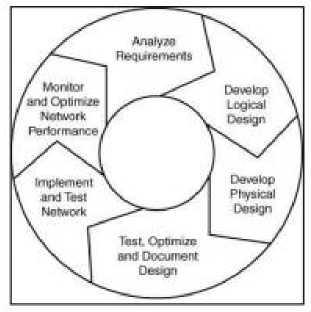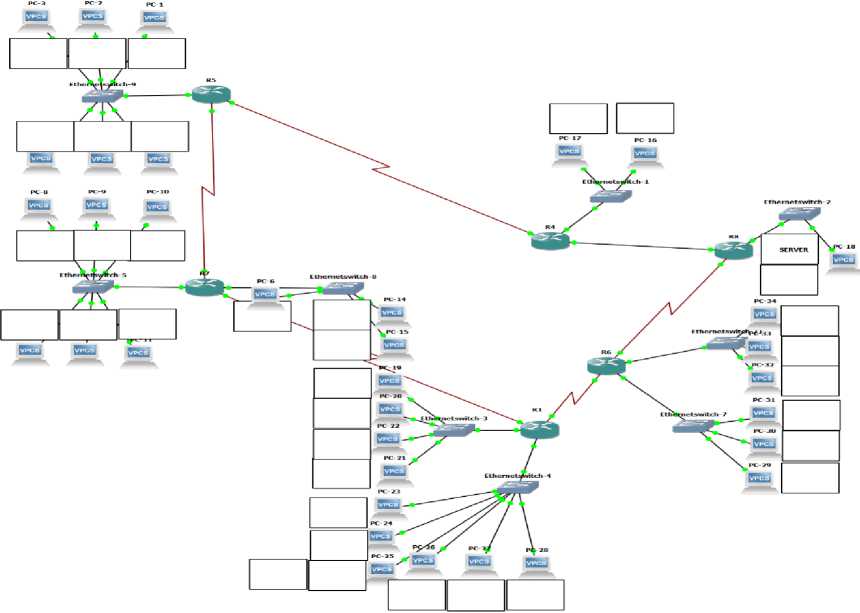Designing a Computer Network in Building a Smart School with Case Study of SMA Negeri 1 Kediri
on
p-ISSN: 2301-5373
e-ISSN: 2654-5101
Jurnal Elektronik Ilmu Komputer Udayana
Volume 8, No 2. November 2019
Designing a Computer Network in Building a Smart School with Case Study of SMA Negeri 1 Kediri
Ni Putu Ega Meiliana Wijayaa1, I Komang Ari Mogia2
aInformatics Department, Udayana University Bali, Indonesia 1egameiliana@yahoo.com 2arimogi@cs.unud.ac.id
Abstract
Smart school is a technology-based school concept used in the teaching and learning process in the classroom. The use of educational technology includes an integrated system that assists the educational community in carrying out their respective functions with the aim of developing the potential of students. The use of technology in the field of education is expected to help and facilitate students and schools in conducting learning so that technology is able to facilitate and solve problems in learning.
In building smart schools, it is also necessary to design technology developed in technology. The concept of network development that will be used is to use the Top-Down method and the topology used is to use ring topology and star topology. With the development of smart schools, it is expected that education using technology will continue to develop.
Keywords: Computer Networks, Network Topology, Smart school, Technology, Top-Down Method
Indonesia is a developed and developing country. As a developed country, it can be seen that the digitalization era in Indonesia has led to the rapid use of technology. As a developing country it can be seen from the facilities where there are still many schools that are still lagging behind or have not used technology. Technological developments are very beneficial for education such as the use of the internet in finding and managing information. The internet has proven to make it easier for users to communicate with each other to get the information they need. Internet technology makes teaching and learning easier, finding various information related to education, and managing administration. In the use of the internet can not be separated from computer networks. A computer network is a relationship of 2 or more devices that are connected or communicating with each other. To build a network it is necessary to consider the hardware and topology of the network.
The construction of the Smart School was chosen to pursue the pursuit of Indonesia's underdeveloped education level compared to other highly developed countries. The progress of a country can also be seen from the development of education, therefore the discussion was chosen regarding the design of Smart Schools which aims to collaborate the education system in schools with technological developments so that the teaching and learning process can be more advanced and gradually improve the quality of teaching, quality of knowledge, quality the ability of students and teachers or the people involved. This is also supported in Article pasal 31 UUD 1945 No.5 which reads: "Pemerintah memajukan Ilmu pengetahuan dan teknologi dengan menjunjung tinggi nilai agama dan persatuan bangsa untuk kemajuan peradaban dan kesejahteraan umat manusia".
Computer network is the relationship between computers to communicate with each other by exchanging data or information. The network helps maintain information that is reliable and up-
to-date. The network helps speed up the process of sharing data. Networks help work processes and communication more efficiently.
Based on the Network Data Transmission media divided into two namely:
-
a. Wired Network (Wired Network) On this network, to connect one computer with another computer, a network cable connection is required. Network cable functions in sending information in the form of electrical signals between network computers.
-
b. Wireless Network (Wireless Network) Is a network with a medium in the form of electromagnetic waves. In this network there is no cable needed to connect between
-
c. computers because it uses electromagnetic waves that will send information signals between network computers.
In the construction of a network infrastructure needed the name of design methods and techniques for building a computer network itself. There are several types of methods in computer network planning, including:
-
a. Bottom-up method
-
b. Top-down method
-
c. PPDIOO method
According to Setiabudi (2009) to build a system, stages are needed so that the development can be known for its development and facilitate the supervision in case of irregularities.
In Top-Down Technique local computer network development is carried out by top management or decision makers by providing all the equipment needed by all departments. This technique is used to
build a network from scratch (zero), this technique does not experience problems in integration but it could be that each department feels their needs are not met.
Network topology is the thing that explains the geometric relationships between the basic elements making up the network, namely nodes, links, and stations. Types of Network Topology:
-
a. Bus Topology
In this topology all centers are directly connected to the transmission medium with a configuration called a bus. Signal transmission from a central is not streamed simultaneously in two directions. Bus tology uses the unicast, multicast and broadcast methods.
-
b. Star Topology
This topology is a centralized topology, all links must pass through the center that distributes the data to all clients that it chooses.
-
c. Ring Topology
The ring method connects the computer so that it is circular and each node has the same rate.
-
d. Mesh topologyThis topology fully implements inter-central relations.
The number of channels to be provided to form a mesh network is the central number minus 1 (n-1, n=central number). The level of complexity of the network is proportional to the increasing number of central installed.
-
e. Tree Topology
This topology is often called a hybrid topology because it is a network formed from various topologies and technologies. A hybrid topology has all the characteristics of the basic topology contained in the network.
This study uses the Top-Down Approach method, where the decision makers of an organization take the decision to build a network by calculating the needs of computers and facilities for all units in the agency (Goldman, 2004).
The development of local computer network design is carried out in 4 phases main (P. Open Heimer, 2011):
-
1. Analyzing Needs
At this stage produces a model of local network development needs of agencies. This phase begins by gathering information on needs through surveys and interviews. Then measure the quality of existing local networks.
-
2. Building a Logical Network Design
At this stage, based on the resulting demand model, a logical local network design is developed such as logical topology, network address mapping, security planning and network management, and network service planning.
-
3. Physical Network Design
At this stage the physical network design results in the selection of technology and computer network infrastructure specifications including cables, switches, access points, and routers, and planning for the placement of network infrastructure devices.
-
4. Testing documenting network design
At this final stage the test is carried out on a computer network design that has been made then see the results of the test. The author implements a test plan, builds a prototype and optimizes network design.

Figure 1. Top-down Method Cycle
From the analysis results obtained a design of several types of school rooms, namely:
-
- 1 Administrative Room
-
- 1 room BK
-
- 1 Computer Lab
-
- 22 Classrooms
-
- 1 Teacher's Room
-
- 2 Practicum Labs
-
- 1 Osis Room
-
- 1 Scout Room
-
- 1 Dance Room
-
- 1 Server Room
From the various rooms available there are school plans and designs from logical network designs and physical network designs, each class block will be installed with internet access points. In this design each room is provided internet access through an existing access point. Each access point will be connected to a switch. Each class is provided 1 pc for teachers who are used to attendance and support teaching. In this application using ring topology and star topology.

Figure 2. Computer Network Communication Design
Then in terms of supporting teaching activities activities will use Wi-Fi to make it easier to find references when conducting teaching and learning activities, as well as a web server can be used to make e-learning that is useful when there are teachers who are unable to attend so they can provide materials and assignments. To utilize and implement this system, it is necessary to disseminate information evenly before first understanding and can utilize the system that will be created.
From the results of this study there are several aspects that can support education, especially relating to Computer Networks, ease of attendance, school safety and supporting teaching equipment activities. To utilize and implement this system, it is necessary to disseminate information evenly before first understanding and can utilize the system that will be created.
References
-
[1] . Abdul, FA dan Budiman, Moh.Ihsan. 2018. Perancangan Jaringan Komputer Dalam Konsep Smart School dengan Menggunakan Metode Top-Down. Jawa Barat: STIMIK Sumedang.
-
[2] . Hariyadi, Charles. 2009. Graf Dalam Topologi Jaringan. Bandung: Institut Teknologi Bandung.
-
[3] . Rizal, Syahril., Saputra dan Benny Wilson. 2018. Penerapan Metode Top-down dalam Pengembangan Jaringan Komputer Lokal Perusahaan. Palembang : Universitas Bina Darma.
-
[4] . Ulinuha, Agus dan Gunawan, Dedi. 2015. Perancangan Dan Implementasi Jaringan Komputer Dengan Studi Kasus Di Smk Muhammadiyah 2 Sragen. Surkarta: Universitas Muhammadiyah Surakarta.
180
Discussion and feedback